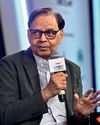
FIVE YEARS AGO, the National Payments Corporation of India (NPCI), a lesser-known organisation pioneering financial infrastructure in the country, held an offsite meeting for senior management under Dilip Asbe, the newly appointed MD & CEO.
The mood was one of optimism, as NPCI was celebrating the success of the Unified Payments Interface (UPI) in achieving 1 billion transactions per month. UPI, introduced in April 2016, facilitates swift, 24/7 money transfers between bank accounts in India via a QR code. Not content with that milestone, Asbe—an engineer by training who has had stints with BSE, global money transfer giant Western Union, and payments player Euronet Asia Pacific—surprised everyone by announcing a target of processing 1 billion transactions a day within five years.
At that time, NPCI was handling approximately 25 million transactions a day, a considerable 37 times lesser than Asbe’s ambitious goal. Fast forward to today, and though the target hasn’t been met, UPI transactions are breaking records, registering a remarkable 393 million transactions each day, just three times shy of the initial target. Enter the disruptors: The pandemic, which accelerated digital payments; non-bank giants like GPay and PhonePe pushing boundaries with cashbacks; and distributing ubiquitous QR codes to small merchants, from chaiwallahs to vegetable vendors. New use cases, which Asbe was banking on, also emerged, ranging from paying utility bills and investing in the stock market to global remittances and beyond.
This story is from the {{IssueName}} edition of {{MagazineName}}.
Start your 7-day Magzter GOLD free trial to access thousands of curated premium stories, and 9,000+ magazines and newspapers.
Already a subscriber ? Sign In
This story is from the {{IssueName}} edition of {{MagazineName}}.
Start your 7-day Magzter GOLD free trial to access thousands of curated premium stories, and 9,000+ magazines and newspapers.
Already a subscriber? Sign In

"Do what's best for employees"
BEST ADVICE - PANKAJ JATHAR | CEO | NIIT LTD

Your Palate for 2025
What's in store for you in the New Year when you go out for a meal or a drink? We ask industry experts to predict F&B trends for 2025

"RBI'S STANCE SHOULD BE TO KEEP THE RUPEE MORE VOLATILE"
Axis Bank Chief Economist Neelkanth Mishra talks about the rupee, quantitative easing, the Trump impact, and more

"We should strive towards two non-zero GST rates"
Arvind Panagariya, Chairman of the 16th Finance Commission, on further reforms in the economy, the Nehruvian era and its impact on policymaking, cash transfers, and more

A GENERATION MAROONED
This generation is creating new grammar for social and professional existence. They are reimagining the very concept of work, identity, and social belonging

A TIME OF UNCERTAINTY AND OPPORTUNITY
A look at the key trends that will redefine how content will be created, distributed, and consumed

Consciousness Shaping Consumption
India has a dynamic and discerning consumer base, whose consumption pattern is experiencing a significant transformation

THE NIFTY ELEPHANTS
The composition of the Nifty 50 index has undergone notable changes in the past 30 years, with only 11 companies consistently remaining in the index. It is expected to undergo further changes in 2025 with the entry of new-age companies like Zomato

REDEFINING THE DIGITAL AGE
For Bitcoin, its future lies not as a currency but as a cornerstone of the modern financial ecosystem

THE FUTURE OF HEALTHCARE
As AI advances, so will its role in health insurance. In the future, it shall perform a variety of complex tasks, making it more accessible and aligned with individual needs